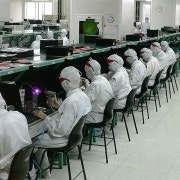Is the US manufacturing revival built to last?
It’s no secret that the manufacturing sector in the United States has been in decline for the past three decades. But a strong rebound in durable goods, such as cars and electronics, has helped revive the manufacturing sector and has supported the post-recession recovery.
As of early 2013, manufacturing output was only four percentage points below its pre-recession peak. Comparing across countries, the United States has performed more strongly than most of its G-7 counterparts, with the exception of Germany. Yet the recovery in Germany has stagnated since mid-2011, while the US recovery continues to gather steam.
Is this strong rebound in US manufacturing here to stay, or just a temporary phenomenon?
A lopsided recovery
Our new study, The US Manufacturing Recovery: Uptick or Renaissance?, looks at the US manufacturing sector and shows that while the headline recovery numbers for US manufacturing are impressive, they mask significant differences between the sectors producing durable goods and nondurable goods (such as food and clothing).
The post-recession recovery has been driven almost entirely by a rebound in durable goods production. On the other hand, nondurable goods have fared poorly – their production is still 10 per cent below its pre-recession levels and only 6 per cent above its trough.
Even within the durable sector, production growth rates have varied substantially. Automobiles, computers and electronics, and machinery have driven the majority of the rebound. However, the rebounds in machinery and automobiles have strong cyclical components (both had declined substantially during the crisis), while growth in the production of computers and electronics has been unrelenting over the last decade.
The energy revolution
What factors can explain the strong rebound in durable goods production in the United States?
Lower labour costs in the United States compared with those in emerging markets have been the most important factor in explaining the recent revival in US manufacturing. But other factors, such as a more competitive real exchange rate (a depreciation of the dollar relative to other currencies, corrected for differences in inflation) and lower energy prices may have also played a significant role.
The increasing US production of oil and gas through unconventional extraction techniques – such as natural gas extracted from shale rock formation – could provide a boost to the manufacturing sector. However, our analysis suggests that the “pull” from the energy boom to manufacturing has been limited. Based on the scenarios in the 2013 Annual Energy Outlook by the US Energy Information Administration, additional production of oil and gas would result in a positive contribution to manufacturing growth of around 0.1 to 0.3 percentage points per year through the end of the decade.
Nondurable goods, such as the production of chemicals or primary metals, would benefit much more than sectors that rebounded strongly from the recession, such as computers and electronics and automobiles.
Tapping into emerging markets
While manufacturing production as a share of total GDP has been declining for decades, manufacturing exports as a percentage of total exports have remained relatively stable. This continued strength can, in part, be explained by increased sales of nondurable goods, especially chemical products and plastic materials, to emerging markets over the past decade. While total production of nondurables remains weak post-recession, these sectors stand to gain the most from structural changes in the US market, such as decreasing energy and labour costs.
Exports of durable goods have been less impressive, but even here there is a bright spot. Export patterns have changed directions as growth in consumption of durable goods such as machinery have moved away from advanced economies to more dynamic markets, such as emerging markets in Asia.
Tapping into these fast-growing regions could therefore increase the contribution of manufacturing exports to US medium-term growth.
All in all, some sectors have rebounded strongly from the recession, but the viability of a renaissance in US manufacturing largely hinges on a continued reduction in the wage gap between the US and emerging markets, and lower domestic energy prices.
This article was originally published at iMFdirect. Reproduced with permission.
















